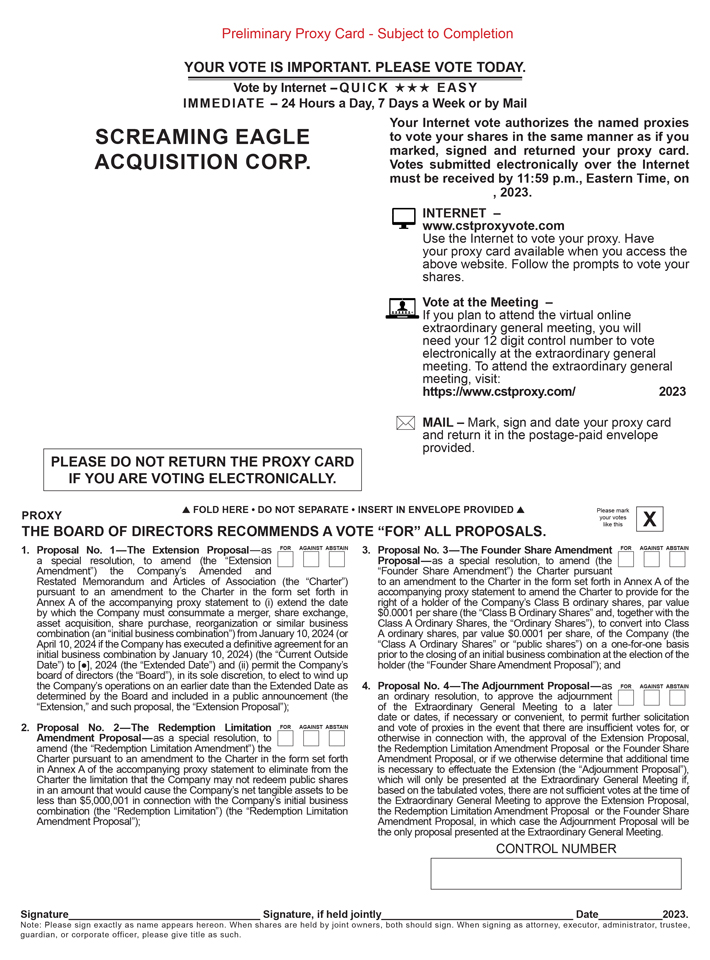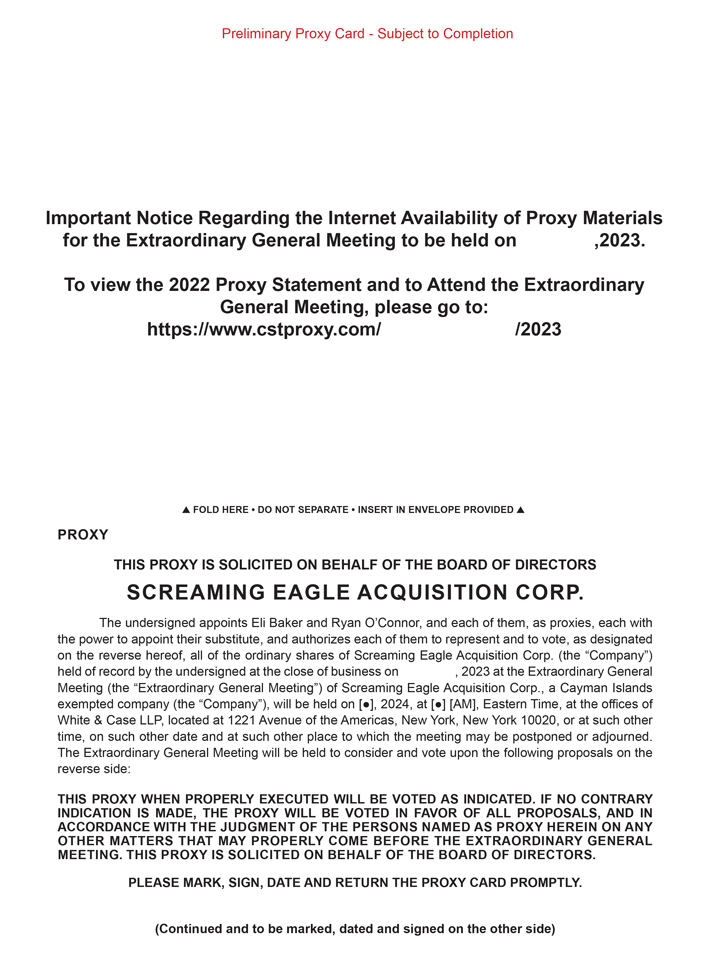QUESTIONS AND ANSWERS ABOUT THE EXTRAORDINARY GENERAL MEETING
These Questions and Answers are only summaries of the matters they discuss. They do not contain all of the information that may be important to you. You should read carefully the entire document, including any annexes to this proxy statement.
Why am I receiving this proxy statement?
This proxy statement and the enclosed proxy card are being sent to you in connection with the solicitation of proxies by our Board for use at the Extraordinary General Meeting to be held in person on [•], 2024, or at any adjournments and/or postponements thereof. This proxy statement summarizes the information that you need to make an informed decision on the proposals to be considered at the Extraordinary General Meeting.
SEAC is a blank check company incorporated on November 3, 2021 as a Cayman Islands exempted company for the purpose of effecting a merger, share exchange, asset acquisition, share purchase, reorganization or similar business combination with one or more businesses (an “initial business combination”).
On November 5, 2021, the Sponsor paid $25,000 to cover certain of the Company’s initial public offering (“IPO”) and formation costs in exchange for 17,250,000 Class B ordinary shares, par value $0.0001 per share (“Class B Ordinary Shares” or “Founder Shares”), or approximately $0.0014 per share. On December 13, 2021, the Company effected a share capitalization of 4,312,500 Founder Shares resulting in the Sponsor holding an aggregate of 21,562,500 Founder Shares. On February 19, 2022, the Sponsor forfeited 2,812,500 Founder Shares to the Company for no consideration, in connection with the IPO underwriters’ election not to exercise the overallotment option granted to them at the end of the 45-day option period on February 19, 2022.
On January 10, 2022, the Company consummated its IPO of 75,000,000 units at $10.00 per unit. Each unit consists of one Class A ordinary share, par value $0.0001 per share, of the Company (“Class A Ordinary Shares” or “public shares”) and one-third of one redeemable warrant to purchase one Class A Ordinary Share. Simultaneously with the consummation of the IPO, SEAC completed the private placement of 11,733,333 private placement warrants (the “Private Placement Warrants”) each exercisable for one Class A Ordinary Share at a purchase price of $11.50 per share, to the Sponsor, generating gross proceeds to us of $17,600,000. Following the closing of the IPO and over-allotment, a total of $750,000,000 of the net proceeds from its IPO and the sale of the Private Placement Warrants were placed in with Continental Stock Transfer & Trust Company (“Continental”) acting as trustee. Our Charter provides for the return of the IPO proceeds held in the Trust Account to the holders of public shares if we do not complete our initial business combination by January 10, 2024 (or April 10, 2024 if we have signed a definitive agreement for an initial business combination by April 10, 2024).
The Board has determined that there may not be sufficient time before January 10, 2024 (the “Current Outside Date”) to sign a definitive agreement for an initial business combination. Therefore, the Board has determined that it is in the best interests of the Company’s shareholders to extend the date by which the Company has to complete an initial business combination to [•], 2024 (the “Extended Date”). The Board also believes that it is in the best interests of the Company’s shareholders to provide additional flexibility to wind up the Company’s operations, in which case it will liquidate the Trust Account and dissolve in accordance with applicable law and to redeem all public shares.
If the Redemption Limitation Amendment Proposal (as defined below) is not approved and there are significant requests for redemption such that the Company’s net tangible assets would be less than $5,000,001 upon the consummation of a business combination, the Charter would prevent the Company from being able to consummate an initial business combination even if all other conditions to closing are met. The Company believes that the Redemption Limitation (as defined below) is not needed. The purpose of such limitation was initially to ensure that the Company would not be subject to the “penny stock” rules of the U.S. Securities and
2

